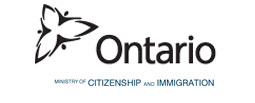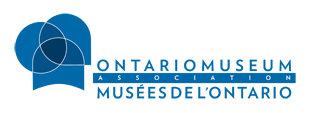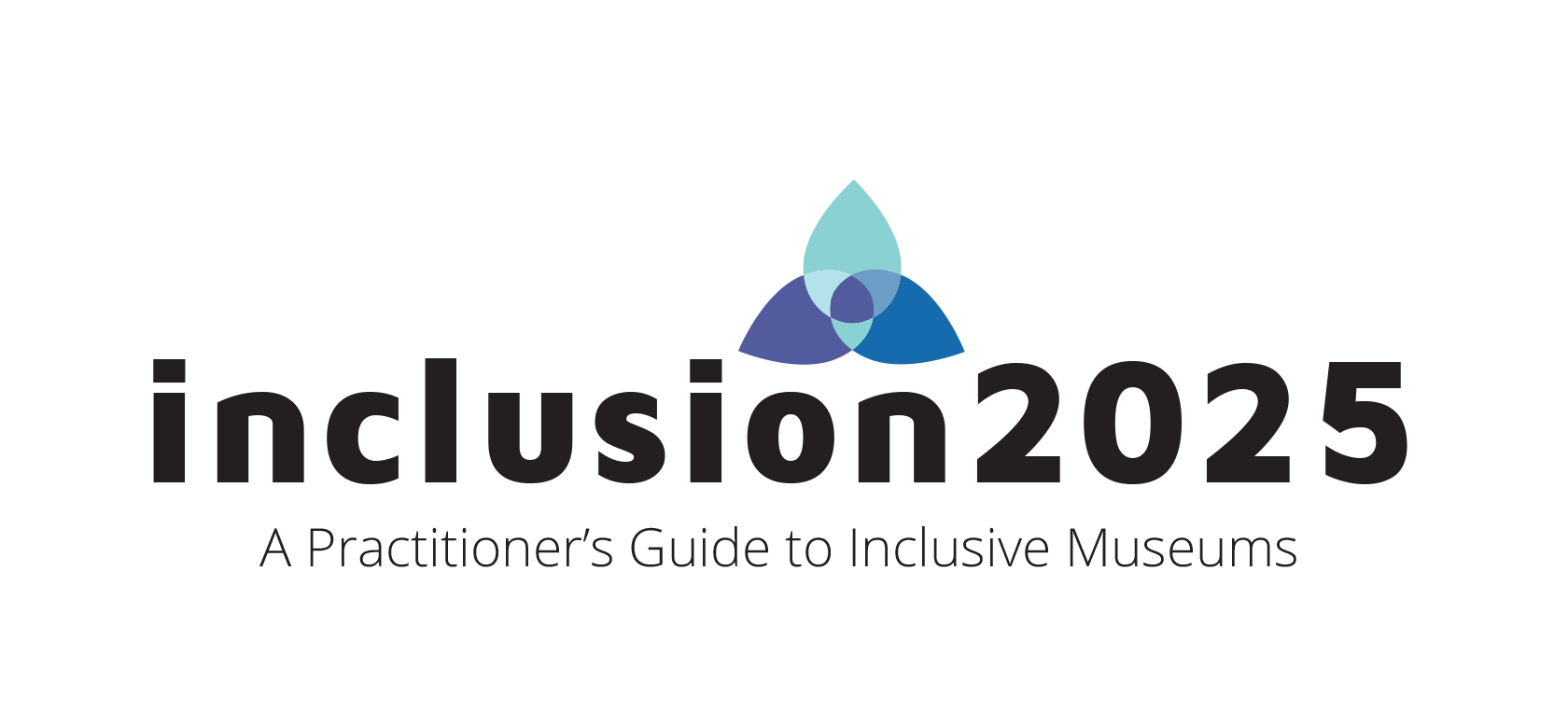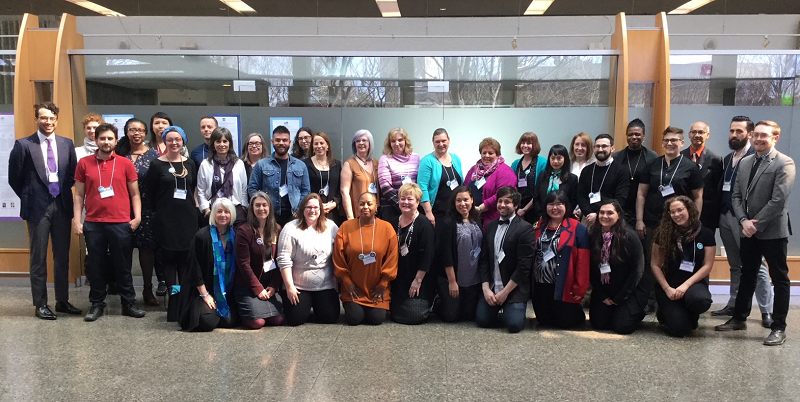Inclusion 2025: About
|
|
|
Guiding Principles | Development Process | How to Use Inclusion 2025 |

At a panel discussion at the Ontario Museums Association (OMA) Conference 2016, Towards the Future: Diversity and Inclusion, the OMA, the Royal Ontario Museum (ROM) and the Canadian Centre for Diversity and Inclusion (CCDI) publicly announced our collective intention to engage Ontario museums in a collaborative project to make our sector more diverse and inclusive. We challenged the community to reflect critically on the current gaps in diversity and inclusion in our sector and respond in a meaningful manner to long-present community voices calling for substantive change. We recognize that calls to action are not enough, and are committed to continuing our work to do right by our communities, audiences, staff and volunteers.
The challenge we raised was inspired by conversations that have been happening in the cultural sector for years, possibly decades, and in December 2015, the OMA, ROM and CCDI made a commitment to collaborate to enhance diversity and inclusion in concrete ways. Under the leadership of Marie Lalonde, OMA Executive Director, Cheryl Blackman, ROM AVP Audience Development, and Cathy Gallagher-Louisy, CCDI Senior Director, Consulting, it was decided to leverage the OMA’s Ontario’s Museums 2025 vision and work across the province, the ROM’s award-winning work in museums engaging communities through the ROM Community Access Network and the ROM Diversity and Inclusion Committee (previously the Accessibility Advisory Committee), and CCDI’s expertise in diversity and inclusion research to develop and implement three primary project deliverables:
- A Diversity Census and Inclusion Survey of Ontario museums, to gauge current state demographic diversity and feelings about inclusion across the sector;
- An Emerging Museums Professional Mentorship project, which was delivered in partnership with Museums of Mississauga and Peel Art Gallery Museum and Archives in 2017; and
- A Guide to Inclusive Museums, to cover key areas of museum work and be developed in partnership with 10 museums across the province, who in turn would have mentorship and advisory access to a committee of leaders in diversity and inclusion in the cultural sector. Inclusion 2025 is the result of this work.
If the museum of the future is driven by, entrenched in, and indistinguishable from, community, then how can we support museums and museum professionals in the complex work of becoming diversity and inclusion champions? As many working in the field can attest, there is no clear roadmap to diversity and inclusion. Inclusion 2025 is therefore not a definitive toolkit but rather a collection of tools, guidelines, cases, strategies and practices that museums can use to increase their capacity and effectiveness in addressing accessibility, diversity, inclusion and equity. It is informed and inspired by the OMA’s vision for the Ontario museum sector, Ontario’s Museums 2025, the Ministry of Tourism, Culture and Sport’s 2016 Ontario’s Culture Strategy, and reports like the Indigenous Collections Next Steps.
We believe that museums and museum professionals are enriched by prioritizing diversity and inclusion, and we are committed to challenging established practice and advocating for greater access, diversity, inclusion and equity across the sector. Moving forward, we will continue to be responsive to community needs, and develop and share resources, practices and learnings that will support efforts to integrate diversity, equity and inclusion throughout the culture sector.
We invite you to join us on our journey towards Inclusion 2025.
A note about this resource:
We recognize that diversity and inclusion is a complex ongoing process of learning and adapting which can shift from context to context based on community needs. Therefore, we propose that the information and resources offered in this guide should not be seen as an authoritative resource, but rather as a collection of guidelines and learnings from culture professionals and institutions who are themselves continuously learning about diversity and inclusion. This project aims to push the envelope, share collective learnings and open the conversation. We understand that mistakes may be made, and there will not always be successes. Nevertheless, we stress that we truly value, respect and appreciate all initiatives that aim to support the vision of Inclusion 2025.
We also acknowledge the other resources and guidelines around diversity and inclusion that have been developed by other organizations, some of which can be found in our Resources page. Our goal is that Inclusion 2025 sparks conversation and dialogue on the necessity of practicing diversity and inclusion when doing museum work, and supports individuals who want to advocate for this need in their own museum communities.
We also recognize that though we will engage different communities, there may be times where some voices are not present. We apologize for this in advance, and invite any community who feels they are not represented to please reach out to [email protected] and let us know. We commit to doing better. Moreover, we respect and understand that while we continue to work with community partners, we do not represent their voices, needs and perspectives.

The Museum Accessibility, Inclusion and Engagement Collaborative
In 2015, the OMA, ROM and CCDI formed the Museum Accessibility, Inclusion, and Engagement Collaborative (MAIEC), with the commitment to collaborate in making the museum sector more inclusive and representative of the diverse population of Ontario.
Ontario Museum Association: The OMA strengthens capacity among institutions and individuals active in Ontario’s museum sector, facilitates excellence and best practices, and improves the communication and collaboration of its membership. The Association advocates for the important role of Ontario’s museums to society, working with all stakeholders, related sectors and industries, and other professional organizations.
Royal Ontario Museum: The ROM is Canada’s largest museum with collections that span art, culture and nature from across time and around the Globe. Among North America’s most renowned museums, the ROM is home to more than 12 million objects and specimens, 40 galleries and exhibitions spaces and a range of fascinating exhibitions, lectures, tours and events. From contemporary art and fashion textiles to South Asian art and culture, from dinosaurs and science to the history of Canada, the ROM invites you to explore and discover a remarkable array of offerings that will delight and inspire visitors of all ages.
Canadian Centre for Diversity and Inclusion: CCDI is a forward-looking social organization with research and learning woven into its DNA, tracing how people identify alongside demographic trends within the Canadian workplace to move employers from diversity to inclusion.
CCDI’s mission is to help those they work with be inclusive, free of prejudice and discrimination – and to generate the awareness, dialogue and action for people to recognize diversity as an asset and not an obstacle.
(Above: A group photo of the project team, catalyst and advocates from our ten partner museums and members from our advisory committee at the Inclusive Museum Leadership Symposium at the Ontario Science Centre. Not pictured here, advisory committee members Penny Pine, Ravi Jain and Jutta Treviranus).
Ten (10) Partner Museums
MAIEC engaged ten (10) Partner Museums from across Ontario’s tourism regions to help develop content around a particular aspect of museum work in their own space. Each museum partner had a team of two staff: a Catalyst, an emerging museum leader committed to effecting diverse and inclusive change, and an Advocate, a member of their museum’s management team who supports the Catalyst.
The Partner Museums are:
- Art Gallery of Sudbury/Galerie d’art de Sudbury (Sudbury)
- Ermatinger • Clergue National Historic Site (Sault Ste. Marie)
- Hamilton Civic Museums (Hamilton)
- Markham Museum (Markham)
- Museum Windsor (Windsor)
- Niagara Falls Museum (Niagara Falls)
- Robert McLaughlin Gallery (Oshawa)
- Simcoe County Museum (Minesing)
- Toronto Ward Museum (Toronto)
- Waterloo Region Museum (Kitchener)
Eleven (11) Advisory Committee Members
The project was also supported by the vision and expertise of our Advisory Committee, composed of eleven (11) cultural leaders and innovators from across Ontario. These individuals are recognized for their outstanding work advancing diversity, equity and inclusion in Ontario’s cultural sphere.
The Advisory Committee members are:
- Cheryl Blackman, Assistant Vice President, Audience Development, Royal Ontario Museum
- Karen Carter, Executive Director, Myseum of Toronto
- Pauline Dolovich, Principal, Reich + Petch
- Shelley Falconer, President and CEO, Art Gallery of Hamilton
- Ravi Jain, Founding Artistic Director, Why Not Theatre
- Cara Krmpotich, Associate Professor and Director of Museum Studies Program, Faculty of Information, University of Toronto
- Jess Mitchell, Senior Manager, R+D and Design, Inclusive Design Research Centre, OCAD University
- Penny Pine, Collections Coordinator, Canadian Museum of History
- Vishnu Ramcharan, Specialist: Visitor and Community Engagement, Ontario Science Centre
- Anita Small, Founder and Owner, small LANGUAGE CONNECTIONS; Co-Founder and Past Co-Director, DEAF CULTURE CENTRE
- Jutta Treviranus, Professor and Director, Inclusive Design Research Centre, OCAD University
Learn more about our Advisory Committee members here.

The development of this guide has been one of continuous self-reflection. At every step, we have considered: why we do this work, who we do it for, and how are we positioned within a much larger system. As we move forward on this journey, we propose the following guiding principles as integral to diversity, inclusion and equity work. We welcome you to adopt them as your own or use them as inspiration as you develop your own principles.
1. Self-Reflection and Self-Awareness
- Inclusion and equity work often begins with critical self-reflection on how our personal, professional, organizational identity and/or social positions (identity, motivations, skills) aligns with the communities we aim to engage.
- How do our positions, biases and/or assumptions inform the work we currently do? How do they inform the relationships we want to develop, the perspectives we want to hear, and the communities we want to participate? If you’re not sure, we recommend by starting with your own blind spots. What bias might you unconsciously hold? One useful tool for understanding your own biases is the online Harvard Implicit Association Test.
2. Prioritize Community and Build Relationships
- Organizational structures, programs and process must be designed or adapted to meet the community context and foster community contributions. See how our museum partner Simcoe County Museum engaged their community with the Affirmation Bowls Project.
- Our work must continue to be responsive to the needs and interest of our diverse communities.
- Active community engagement must be incorporated into vision, planning and goals of an organization, its operations and programming.
- Meaningful relationships with communities are built and strengthened over time.
3. Representation and Visibility
- A diverse and inclusive museum is one that is attentive to who are and are not represented in its audiences, staff and volunteers, and community. It is good to continuously ask, “Who is missing and why?”
- Representation is multilayered. Considerations include: people (who), representation in terms of form, process (how), content (what), and setting and the environment (where).
4. Diversity and Inclusion is a Process
- Diversity and inclusion practices and work are constantly evolving depending on context. It requires flexibility and adaptability that can respond to and implement ongoing change.
- Keep an open mind, and allow yourself space and time to collaborate on and think through ideas. A useful frame of reference is the Inclusive Design approach, and you can find useful information on Inclusive Design on the OCAD University Inclusive Design Research Centre website.
- This work can be complex, challenging and stressful, be mindful of burnout, and take time for self-care. See our self-care section for some useful tips on managing the emotional work of becoming and being a change agent.
5. Beyond Tokenism
- Change over the long-term requires a commitment to organizational and programmatic restructuring; it demands that inclusion and non-dominant perspectives be recognized as integral to all aspects of museum work.
- What you focus on grows. It is important to be mindful of where attention, time and energy is spent and that diversity and inclusion design are intrinsic to action.
- Recognize that work has already been done. Where possible, build upon or contribute to existing community initiatives rather than imposing externally derived projects and programs.
6. What Gets Measured Gets Done
- It is essential to establish methods of measurement to track goal progress. This allows for transparency and accountability in our work, as well as the opportunity to learn from successes and failures.
- Measures should be inclusively designed to ensure all groups are represented.
- Consider ‘who is missing and why?’ Data that is aggregated too comprehensively can leave small minorities misrepresented or excluded.

Identification of the Gap
At the initial meeting between the OMA and the ROM in December 2015, the team agreed that there were gaps between the inclusive museum sector we wanted to become, and the museum sector as it currently was. This is through no fault of individual museums, but rather the result of systemic structures that create barriers between museums and the public we serve.
Under the leadership of Executive Director Marie Lalonde, the OMA has done extensive work in this area, most notably with Ontario’s Museums 2025 and with annual symposia that create conversations around important subjects such as decolonizing collections, relationships with Indigenous communities, and diversity and inclusion in general.
At the ROM, Cheryl Blackman, AVP Audience Development, has created the ROM Community Access Network (ROMCAN) and the ROM Diversity and Inclusion Committee (formerly the Accessibility Advisory Committee) to meaningfully engage with community members in planning and delivering museum experiences.
Both organizations agreed there was a need for more, and a vision to scaffold on existing work to do better, not just for individual museums but for the Ontario museum sector as a whole. Some of the questions that arose include:
- How do we quantify the gap we know exists? (What gets measured gets done.)
- How do we ensure community voices drive our process?
- How can we create opportunities for aspiring museum professionals from underrepresented communities to join the sector and create meaningful change?
- How do we support museums that are committed to diversity and inclusion, but may not know how to start?
Ideation
Some ideas that came out of that initial meeting were:
- Invite the Canadian Centre of Diversity and Inclusion to the project team, as a leading expert in diversity and inclusion and particularly in metrics around these topics. Cathy Gallagher-Louisy, Senior Director, Consulting, brought CCDI on board as the third project partner.
- Survey staff in the museum sector to determine current state diversity demographics and perceptions around inclusion (CCDI Diversity Census and Inclusion Survey)
- Analyze ROM Audience Research to determine some initial gaps we could potentially use as a starting point. Alexander Johnston, ROM Audience Insight Coordinator, would lead that part of the work as well as serve as the project team lead for research.
- Develop a mentorship program for emerging museum professionals from underrepresented communities to deliver, under the guidance of museum leaders, a community project informed by community focus groups.
- Deliver a Framework for Action that will provide tips and strategies for museums who are looking for resources in developing and implementing their own diversity and inclusion strategy.
The OMA, with the support of the ROM and CCDI, applied for grant funding for this project, and in 2016 received funding from the Ontario Trillium Foundation and the Ministry of Citizenship and Immigration. OMA Project Coordinator Rhiannon Myers was hired to manage the project deliverables, with the support of ROM Audience Coordinator Jaclyn Qua-Hiansen.
As the project evolved, the “Framework for Action” developed as well into an Inclusive Museums Toolkit, and later on a Practitioner's Guide that includes resources and cases that practitioners can refer to. Whereas the original idea was to develop this resource internally using data from audience research, museum staff surveys and community focus groups, the team realized that such a resource cannot come from a single collaborative, nor can it be as definitive a resource as the term “framework” suggests. More importantly, given the diversity of communities across Ontario and the diversity of museums in terms of size, collections and communities served, such a resource can only be useful if created by a plurality of perspectives.
As such, the team decided to invite museums from across Ontario to partner with MAIEC in developing and creating Inclusion 2025. The goal was to get representation across tourism regions and including a diverse range of museum types.
Research
For the introductory sections, OMA Inclusive Leadership Assistant Temma Pinkofsky and ROM Inclusion Advisor Christian Blake consulted with CCDI and the Advisory Committee, as well as conducted independent online research, to compile information on diversity and inclusion definitions, data-based research, and resources for further reading.
To develop each case study under Inclusion in Action, an emerging museum leader (“Catalyst”) and a senior manager (“Advocate”) at each Partner Museum collaborated to research diversity and inclusion resources, guidelines and best practices around a particular aspect of museum work: collections development, exhibitions and curatorial practice, community engagement, volunteer and HR policies, facilities design, events and programming, marketing and communications, interpretation and education, and audience insight.
Community Engagement
Where applicable, Partner Museum teams connected directly with community groups and members to ensure that their project was in-line with any current initiatives, as well as to invite the community participation in to the project itself.
Pilot Project
Partner Museums implemented a pilot project in their particular area of focus. This process was guided and supported by phone consultations with members of the Advisory Committee, the ROM Inclusion Advisor Christian Blake and OMA Project Coordinator Rhiannon Myers. All the members of the Advisory Committee had selected specific cases to consult on based on their areas of expertise
Inclusion in Action - Case Study
Partner Museums reflected on, and wrote about, what they’ve learned from their experiences. These experiences can be found in the Inclusion in Action section of this guide, with the compilation of all case studies covering a wide breadth of museum operations.
Guide Design
Concurrently, a subcommittee composed of members of the Advisory Committee and staff from the OMA and the ROM, met to take an inclusive design approach to structuring what would become Inclusion 2025. Using this lens, the subcommittee considered a diverse range of potential users of Inclusion 2025 both within and outside the museum sector.
The Next Chapters
Inclusion 2025 is the result of a long and complex process involving many individuals and institutions. However, this resource is a living document and the development process is by no means complete. Just as we invited 10 museums across Ontario to partner with us in developing this Guide, we invite you to contribute your own experiences of Inclusion in Action and suggestions on Resources that supported your own diversity and inclusion journey. Please feel free to reach out to us at [email protected] with the subject line: “Inclusion 2025: [Museum Name]’s Story of Inclusion in Action” or “Inclusion 2025: Suggested Resources on [Topic].”
We’d love to hear from you and continue scaffolding on this resource to include the experiences from an even wider and more diverse breadth of museums.

Inclusion 2025 is designed to fit your needs, and therefore, there is no particularly ‘correct’ way to use this guide. This resource is for you, whether you want an introduction to principles around diversity and inclusion (Inclusion as a Lens), or you are looking for true stories of institutions implementing inclusion in their own spaces (Inclusion in Action), or you are interested in resources about approaching your particular area of museum work with a diversity and inclusion lens (Resources). Use this guide in a way that suits you and your organization at this particular point in time, and feel free to come back to it for support as your needs change.

This resource was made possible by the generous support of the Ministry of Citizenship and Immigration Partnership Grant Program.




